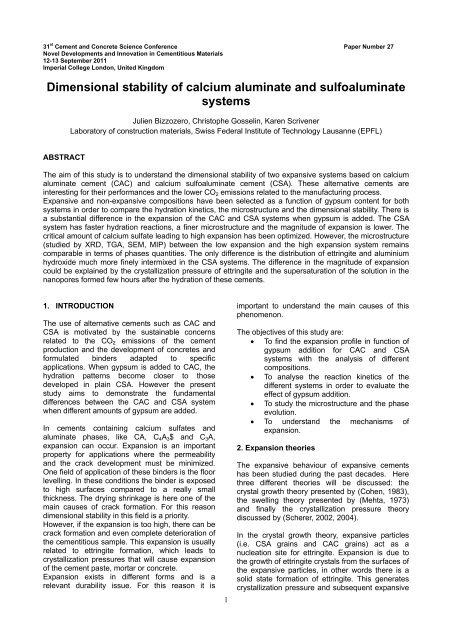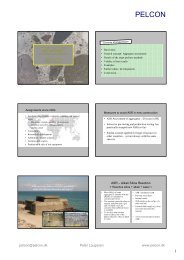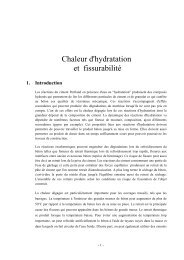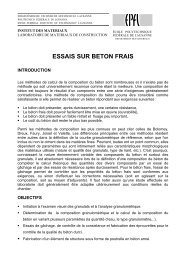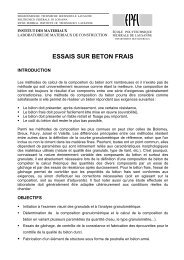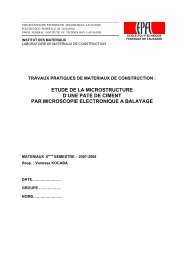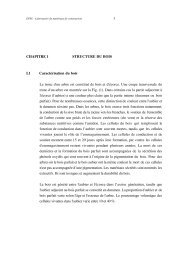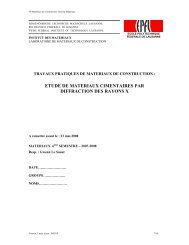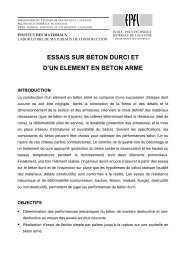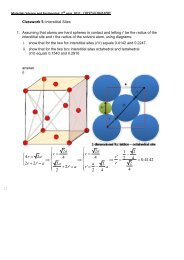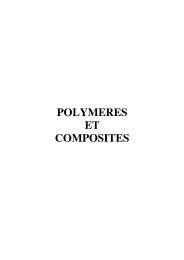Dimensional stability of calcium aluminate and ... - LMC - EPFL
Dimensional stability of calcium aluminate and ... - LMC - EPFL
Dimensional stability of calcium aluminate and ... - LMC - EPFL
You also want an ePaper? Increase the reach of your titles
YUMPU automatically turns print PDFs into web optimized ePapers that Google loves.
31 st Cement <strong>and</strong> Concrete Science Conference Paper Number 27<br />
Novel Developments <strong>and</strong> Innovation in Cementitious Materials<br />
12-13 September 2011<br />
Imperial College London, United Kingdom<br />
<strong>Dimensional</strong> <strong>stability</strong> <strong>of</strong> <strong>calcium</strong> <strong>aluminate</strong> <strong>and</strong> sulfo<strong>aluminate</strong><br />
systems<br />
ABSTRACT<br />
Julien Bizzozero, Christophe Gosselin, Karen Scrivener<br />
Laboratory <strong>of</strong> construction materials, Swiss Federal Institute <strong>of</strong> Technology Lausanne (<strong>EPFL</strong>)<br />
The aim <strong>of</strong> this study is to underst<strong>and</strong> the dimensional <strong>stability</strong> <strong>of</strong> two expansive systems based on <strong>calcium</strong><br />
<strong>aluminate</strong> cement (CAC) <strong>and</strong> <strong>calcium</strong> sulfo<strong>aluminate</strong> cement (CSA). These alternative cements are<br />
interesting for their performances <strong>and</strong> the lower CO2 emissions related to the manufacturing process.<br />
Expansive <strong>and</strong> non-expansive compositions have been selected as a function <strong>of</strong> gypsum content for both<br />
systems in order to compare the hydration kinetics, the microstructure <strong>and</strong> the dimensional <strong>stability</strong>. There is<br />
a substantial difference in the expansion <strong>of</strong> the CAC <strong>and</strong> CSA systems when gypsum is added. The CSA<br />
system has faster hydration reactions, a finer microstructure <strong>and</strong> the magnitude <strong>of</strong> expansion is lower. The<br />
critical amount <strong>of</strong> <strong>calcium</strong> sulfate leading to high expansion has been optimized. However, the microstructure<br />
(studied by XRD, TGA, SEM, MIP) between the low expansion <strong>and</strong> the high expansion system remains<br />
comparable in terms <strong>of</strong> phases quantities. The only difference is the distribution <strong>of</strong> ettringite <strong>and</strong> aluminium<br />
hydroxide much more finely intermixed in the CSA systems. The difference in the magnitude <strong>of</strong> expansion<br />
could be explained by the crystallization pressure <strong>of</strong> ettringite <strong>and</strong> the supersaturation <strong>of</strong> the solution in the<br />
nanopores formed few hours after the hydration <strong>of</strong> these cements.<br />
1. INTRODUCTION<br />
The use <strong>of</strong> alternative cements such as CAC <strong>and</strong><br />
CSA is motivated by the sustainable concerns<br />
related to the CO2 emissions <strong>of</strong> the cement<br />
production <strong>and</strong> the development <strong>of</strong> concretes <strong>and</strong><br />
formulated binders adapted to specific<br />
applications. When gypsum is added to CAC, the<br />
hydration patterns become closer to those<br />
developed in plain CSA. However the present<br />
study aims to demonstrate the fundamental<br />
differences between the CAC <strong>and</strong> CSA system<br />
when different amounts <strong>of</strong> gypsum are added.<br />
In cements containing <strong>calcium</strong> sulfates <strong>and</strong><br />
<strong>aluminate</strong> phases, like CA, C4A3$ <strong>and</strong> C3A,<br />
expansion can occur. Expansion is an important<br />
property for applications where the permeability<br />
<strong>and</strong> the crack development must be minimized.<br />
One field <strong>of</strong> application <strong>of</strong> these binders is the floor<br />
levelling. In these conditions the binder is exposed<br />
to high surfaces compared to a really small<br />
thickness. The drying shrinkage is here one <strong>of</strong> the<br />
main causes <strong>of</strong> crack formation. For this reason<br />
dimensional <strong>stability</strong> in this field is a priority.<br />
However, if the expansion is too high, there can be<br />
crack formation <strong>and</strong> even complete deterioration <strong>of</strong><br />
the cementitious sample. This expansion is usually<br />
related to ettringite formation, which leads to<br />
crystallization pressures that will cause expansion<br />
<strong>of</strong> the cement paste, mortar or concrete.<br />
Expansion exists in different forms <strong>and</strong> is a<br />
relevant durability issue. For this reason it is<br />
1<br />
important to underst<strong>and</strong> the main causes <strong>of</strong> this<br />
phenomenon.<br />
The objectives <strong>of</strong> this study are:<br />
To find the expansion pr<strong>of</strong>ile in function <strong>of</strong><br />
gypsum addition for CAC <strong>and</strong> CSA<br />
systems with the analysis <strong>of</strong> different<br />
compositions.<br />
To analyse the reaction kinetics <strong>of</strong> the<br />
different systems in order to evaluate the<br />
effect <strong>of</strong> gypsum addition.<br />
To study the microstructure <strong>and</strong> the phase<br />
evolution.<br />
To underst<strong>and</strong> the mechanisms <strong>of</strong><br />
expansion.<br />
2. Expansion theories<br />
The expansive behaviour <strong>of</strong> expansive cements<br />
has been studied during the past decades. Here<br />
three different theories will be discussed: the<br />
crystal growth theory presented by (Cohen, 1983),<br />
the swelling theory presented by (Mehta, 1973)<br />
<strong>and</strong> finally the crystallization pressure theory<br />
discussed by (Scherer, 2002, 2004).<br />
In the crystal growth theory, expansive particles<br />
(i.e. CSA grains <strong>and</strong> CAC grains) act as a<br />
nucleation site for ettringite. Expansion is due to<br />
the growth <strong>of</strong> ettringite crystals from the surfaces <strong>of</strong><br />
the expansive particles, in other words there is a<br />
solid state formation <strong>of</strong> ettringite. This generates<br />
crystallization pressure <strong>and</strong> subsequent expansive
force. The expansive particles are covered by a<br />
dense coating <strong>of</strong> ettringite whose further hydration<br />
will increase the thickness <strong>of</strong> the coating layer<br />
(Figure 1). When the thickness <strong>of</strong> the ettringite<br />
layer exceeds that <strong>of</strong> the solution, the particles will<br />
be in contact <strong>and</strong> exert pressure against the<br />
others. This leads to expansion. This expansion<br />
will persist until the gypsum or the expansive<br />
particles will be depleted.<br />
Figure 1. Ettringite coating around an expansive<br />
particle (CSA cement grain) (Cohen, 1983)<br />
In the swelling theory, the expansion is due to the<br />
water adsorption or swelling <strong>of</strong> ettringite which is<br />
formed by a through-solution mechanism, i.e. by<br />
the hydrates precipitation into the pore solution.<br />
This leads to ettringite formation into the bulk,<br />
away from the anhydrous particles. Water<br />
adsorption is possible because ettringite is<br />
microcrystalline (has a colloidal size). The<br />
formation <strong>of</strong> this type <strong>of</strong> ettringite occurs only if<br />
<strong>calcium</strong> hydroxide (CH) is present in the solution. If<br />
<strong>calcium</strong> hydroxide is absent, ettringite crystals will<br />
be larger <strong>and</strong> swelling will not occur.<br />
Scherer studied the expansion with a<br />
thermodynamic approach <strong>and</strong> developed the<br />
crystallization pressure theory. In porous materials,<br />
cement paste, mortar, concrete <strong>and</strong> stone, there<br />
can be a damage caused by the precipitation <strong>of</strong><br />
crystals from the liquid present in the pores. When<br />
the supersaturation level <strong>of</strong> a given salt in the<br />
liquid is reached, there is a precipitation <strong>of</strong> this salt.<br />
Supersaturation depends on the concentration, on<br />
the temperature <strong>and</strong> on the size <strong>of</strong> the pores. So a<br />
crystal growing in a pore will encounter the pore<br />
wall <strong>and</strong> exert pressure on it (Scherer, 2004).<br />
When a crystal is surrounded by a film <strong>of</strong> solution<br />
<strong>and</strong> there are small pores, high stresses appear.<br />
High crystallization pressures require a high<br />
supersaturation <strong>of</strong> the pore solution.<br />
Supersaturation is given by the ratio between the<br />
Ion Activity Product (IAP) <strong>and</strong> the solubility product<br />
(Ksp) <strong>of</strong> the given phase. The species forming<br />
ettringite are:<br />
6 2 4 3 26 <br />
→ .3 .26 <br />
The resulting IAP for this phase is:<br />
IAP=<br />
. . . . <br />
And the solubility product <strong>of</strong> ettringite is given by<br />
(Warren <strong>and</strong> Reardon,1994):<br />
2<br />
10 . for AFt<br />
A crystal in a supersaturated solution will grow until<br />
the supersaturation will be consumed (IAP = Ksp).<br />
Its growth produces a pressure on the pore walls<br />
given by the Correns’ equation (2) (Correns, 1949):<br />
<br />
<br />
<br />
<br />
(2)<br />
Where R=8.314 J/K/mol is the gas constant, T is<br />
the absolute temperature, vm is the molar volume<br />
<strong>of</strong> the crystal (for ettringite vm = 707 cm 3 /mol).<br />
3. Materials<br />
3.1 CAC+C$H2 systems<br />
The hydration <strong>of</strong> CAC systems with <strong>calcium</strong> sulfate<br />
leads to the formation <strong>of</strong> ettringite <strong>and</strong> amorphous<br />
aluminium hydroxide, see reaction (1). For this<br />
study, gypsum (G) will be used <strong>and</strong> the respective<br />
reaction is (2).<br />
3CA+3C$Hx+(38-3x)HC3A.3C$.H32+2AH3 (1)<br />
3CA +3C$H2+32HC3A.3C$.H32+2AH3<br />
(2)<br />
The <strong>calcium</strong> <strong>aluminate</strong> cement (CAC) used for this<br />
project was supplied by Kerneos in France.<br />
These compositions were measured by XRD <strong>and</strong><br />
quantified by the Rietveld refinement.<br />
Table 1. Mineralogical composition <strong>of</strong> CAC cement<br />
Anhydrous phase Cement notation [%wt]<br />
Calcium <strong>aluminate</strong> CA 70<br />
Gehlenite C2AS 20<br />
Ferrites C3FT ~10<br />
Perovskite CT<br />
Spinel MgAl2O4<br />
3.2 CSA+C$H2 systems<br />
The main reaction occurring in CSA systems is<br />
between the ye’elimite phase (C4A3$) <strong>and</strong> <strong>calcium</strong><br />
sulfate. This reaction (3) leads to the formation <strong>of</strong><br />
ettringite <strong>and</strong> amorphous aluminium hydroxide.<br />
C4A3$+2C$H2+34HC3A.3C$.H32+2AH3<br />
(3)<br />
The <strong>calcium</strong> sulfo<strong>aluminate</strong> cement (CSA) used for<br />
this project was supplied by Buzzi Unicem SPA in<br />
Italy.<br />
Table 2. Mineralogical composition <strong>of</strong> CSA cement<br />
Anhydrous phase Cement notation [%wt]<br />
Ye’elimite C4A3$ 50<br />
Belite -C2A 20<br />
Anhydrite + Gypsum C$ + C$H2 22<br />
Calcite C<br />
Aluminates C3A<br />
Brownmillerite C4AF
4. Methods<br />
All the experiments were carried out at 20°C.<br />
Cement pastes were prepared with water/binder<br />
ratio <strong>of</strong> 0.4.<br />
All the mixes were prepared under the same<br />
conditions. Additional gypsum (if present in the<br />
mix) was added in water. Then cement was added<br />
<strong>and</strong> mixed for 2 minutes using a paddle mixer<br />
(1100rpm).<br />
For expansion tests, the cement paste was cast in<br />
special steel moulds <strong>of</strong> 1x1x4 cm 3 . The samples<br />
were then cured for one day at high humidity<br />
environment <strong>and</strong> demoulded after 24 hours. The<br />
first measure <strong>of</strong> the length (~4 cm) was done with<br />
an extensometer having a precision <strong>of</strong> ±1μm. The<br />
samples were conserved into demineralized water.<br />
Hydration kinetics were studied by isothermal<br />
calorimetry with a TAM Air (3114/3236) from<br />
Thermometric.<br />
For SEM, XRD <strong>and</strong> MIP the samples were cast in<br />
polystyrene cylinders <strong>of</strong> 30mm <strong>of</strong> diameter <strong>and</strong><br />
50mm high. After 24hours they were demoulded<br />
<strong>and</strong> placed in recipients containing demineralized<br />
water. For each age <strong>of</strong> curing (1,3,7,14 <strong>and</strong> 28<br />
days) three slices were cut from the cylinders <strong>and</strong><br />
then introduced into isopropanol to stop hydration.<br />
X-ray diffraction (XRD) analysis were done with a<br />
Philips X’Pert Pro PANalytical (CuKα, λ=1. 54 Å)<br />
working in Bragg-Brentano geometry with a 2θrange<br />
<strong>of</strong> 5°-65°.<br />
Scanning electron microscopy (SEM) was done<br />
using a FEI Quanta 200 with an electric beam<br />
generated by a tungsten (W) filament submitted to<br />
a tension <strong>of</strong> 15 kV. The cement paste samples<br />
were impregnated with epoxy resin under vacuum<br />
conditions in order to fill the open porosity with the<br />
resin <strong>and</strong> after were polished <strong>and</strong> coated with<br />
carbon.<br />
Mercury intrusion porosimetry (MIP) was done on a<br />
Porotec machine with pressure capacity <strong>of</strong> 400<br />
MPa. Massive samples <strong>of</strong> about 1.5 grams were<br />
used for the analysis.<br />
Pore solution analyses were done on cylindrical<br />
samples <strong>of</strong> 5cm diameter <strong>and</strong> 10cm high. The<br />
cement paste was casted in plastic bottles <strong>of</strong> the<br />
same size <strong>and</strong> stored for 24hour is sealed<br />
conditions. After the samples were cured for 6 days<br />
under a reduced amount <strong>of</strong> water <strong>and</strong> finally tested<br />
after 7 days <strong>of</strong> hydration. The applied pressure<br />
was 560MPa in order to extract 10ml <strong>of</strong> pore<br />
solution. The cations were analysed with ICP-OES<br />
<strong>and</strong> the anions with ion chromatography.<br />
3<br />
5. Results<br />
5.1 Expansion tests<br />
Figure 2 shows the expansion in function <strong>of</strong> the<br />
time for different compositions <strong>of</strong> CAC with<br />
gypsum. The number on the right <strong>of</strong> the system<br />
name (e.g. B-G1.0) is the molar ratio between C$<br />
<strong>and</strong> CA. With the increase <strong>of</strong> the <strong>calcium</strong> sulfate<br />
content there is an increase in expansion. For a C$<br />
content below 0.7 the expansion seems to be<br />
really low <strong>and</strong> above this ratio the expansion<br />
continues on over time.<br />
Figure 3 shows the expansion for the systems with<br />
CSA <strong>and</strong> gypsum. Here again the expansion<br />
increases with the <strong>calcium</strong> sulfate content <strong>and</strong><br />
there is a critical behaviour. The composition with<br />
the higher amount <strong>of</strong> gypsum broke after 4 days.<br />
There is not a s<strong>of</strong>t transition between low <strong>and</strong> high<br />
expansion for CSA systems. The range <strong>of</strong><br />
expansion <strong>of</strong> these systems is lower than for CAC<br />
systems.<br />
Expansion [%]<br />
Expansion [%]<br />
5.0%<br />
4.0%<br />
3.0%<br />
2.0%<br />
1.0%<br />
0.0%<br />
0 50 100 150<br />
Time [days]<br />
2.0%<br />
1.5%<br />
1.0%<br />
0.5%<br />
crack threshold<br />
B‐G1.2<br />
B‐G1.1<br />
B‐G1.0<br />
B‐G0.92<br />
B‐G0.85<br />
B‐G0.82<br />
B‐G0.67<br />
B‐G0.54<br />
B‐G0.43<br />
B‐G0.25<br />
Figure 2. Expansion <strong>of</strong> CAC with gypsum.<br />
4 days: sample broken<br />
crack threshold<br />
0.0%<br />
0 50 100 150<br />
Time [days]<br />
B‐G0_ref<br />
C‐G1.0<br />
C‐G0.96<br />
C‐G0.92<br />
C‐G0.82<br />
C‐G0.75<br />
C‐G0.70<br />
C‐G0.56<br />
C‐G0.54<br />
C‐G0.5<br />
Figure 3. Expansion <strong>of</strong> CSA with gypsum.<br />
High expansion<br />
Low expansion<br />
High expansion<br />
Low expansion
5.2 Isothermal calorimetry<br />
Isothermal calorimetry is useful to measure the<br />
hydration kinetics <strong>of</strong> the different systems. Figure 4<br />
<strong>and</strong> Figure 5 show that CSA systems have faster<br />
kinetics than CAC systems. Both systems show a<br />
similar behavior: the second peak is delayed when<br />
the gypsum content increases.<br />
Normalized heat flow [mW/g <strong>of</strong> binder]<br />
35<br />
30<br />
25<br />
20<br />
15<br />
10<br />
5<br />
B‐G‐0.25<br />
B‐G0.67<br />
B‐G0.82<br />
B‐G0.92<br />
B‐G1.1<br />
0<br />
0 10 20<br />
Time [h]<br />
30 40<br />
Figure 4. Hydration kinetics <strong>of</strong> CAC with gypsum.<br />
Normalized heat flow [mW/g <strong>of</strong> binder]<br />
35<br />
30<br />
25<br />
20<br />
15<br />
10<br />
5<br />
C‐G0.5_ref<br />
C‐G0.54<br />
C‐G0.56<br />
C‐G0.92<br />
C‐G1.0<br />
0<br />
0 10 20<br />
Time [h]<br />
30 40<br />
Figure 5. Hydration kinetics <strong>of</strong> CSA with gypsum.<br />
5.3 XRD analysis <strong>of</strong> CAC systems<br />
For XRD results <strong>and</strong> SEM results only the CAC<br />
systems are presented in this paper. During the<br />
presentation both CAC <strong>and</strong> CSA systems will be<br />
compared <strong>and</strong> discussed.<br />
Figure 6 <strong>and</strong> Figure 7 show the consumption <strong>of</strong> the<br />
anhydrous phases, CA <strong>and</strong> gypsum, <strong>and</strong> the<br />
formation <strong>of</strong> ettringite on the left axis. On the right<br />
axis the expansion is presented. There is more<br />
ettringite precipitation in the high expansion<br />
system. For the high expansion system it is<br />
important to note that when ettringite formation<br />
reaches a plateau, the expansion continues on<br />
with the time. For CSA systems the behavior is<br />
similar.<br />
4<br />
Intensity [cts]<br />
Intensity [cts]<br />
4.E+07<br />
3.E+07<br />
2.E+07<br />
1.E+07<br />
0.8%<br />
0.7%<br />
0.6%<br />
0.5%<br />
0.4%<br />
0.3%<br />
0.2%<br />
0.1%<br />
0.E+00<br />
0.0%<br />
0 10 20 30<br />
Time [days]<br />
40 50 60<br />
4.E+07<br />
3.E+07<br />
2.E+07<br />
1.E+07<br />
Expansion [%]<br />
CA<br />
Gypsum<br />
Ettringite<br />
Expansion<br />
Figure 6. Low expansion system (B-G0.67).<br />
0.8%<br />
0.7%<br />
0.6%<br />
0.5%<br />
0.4%<br />
0.3%<br />
0.2%<br />
0.1%<br />
0.E+00<br />
0.0%<br />
0 10 20 30<br />
Time [days]<br />
40 50 60<br />
Expansion [%]<br />
CA<br />
Gypsum<br />
Ettringite<br />
Expansion<br />
Figure 7. High expansion system (B-G0.82).<br />
5.4 SEM BSE images <strong>of</strong> CAC systems<br />
Figure 8 <strong>and</strong> Figure 9 show the microstructure <strong>of</strong><br />
low expansive <strong>and</strong> high expansive CAC systems<br />
respectively. The two main hydrates, ettringite <strong>and</strong><br />
amorphous aluminium hydroxide can be easily<br />
distinguished. Ettringite is light grey <strong>and</strong> AHx is<br />
dark grey in the hydrated matrix. The cracks are<br />
mainly due to the sample preparation technique.<br />
There is no substantial difference between the low<br />
expansive <strong>and</strong> the high expansive system.<br />
However there is a difference between CAC <strong>and</strong><br />
CSA systems, the hydrates are more intermixed in<br />
CSA systems so it is more difficult to distinguish<br />
them.<br />
B-G0.67<br />
Figure 8. Low expansion system (B-G0.67).<br />
B-G0.82<br />
Figure 9. High expansion system (B-G0.82).
5.5 MIP, comparison <strong>of</strong> CAC with CSA systems<br />
Figure 10 shows the cumulative pore size<br />
distribution <strong>of</strong> the 4 studied systems. CAC systems<br />
have a bigger cumulative porosity than CSA<br />
systems. The pore size distribution is comparable<br />
for all the systems with a pore size <strong>of</strong> the<br />
nanometric range (around 4 nm).<br />
Porosity [%]<br />
25<br />
20<br />
15<br />
10<br />
5<br />
14 days<br />
0<br />
0.001 0.01 0.1 1 10 100<br />
Pore Radius [µm]<br />
CAC systems<br />
CSA systems<br />
B‐G0.67<br />
B‐G0.82<br />
C‐G0.92<br />
C‐G1.0<br />
LE<br />
HE<br />
LE<br />
HE<br />
Figure 10. Cumulative pore size distribution <strong>of</strong> CAC<br />
<strong>and</strong> CSA systems.<br />
5.6 Pore solution analysis<br />
Figure 11 shows that with the increase <strong>of</strong> gypsum<br />
content there is a strong increase <strong>of</strong> the<br />
supersaturation which leads to an increase in the<br />
crystallization pressure at 7 days <strong>of</strong> hydration.<br />
There is a threshold <strong>of</strong> crystallization pressure at<br />
around 70 MPa above which there is uncontrolled<br />
<strong>and</strong> high expansion.<br />
Ettringite saturation index [‐]<br />
12<br />
10<br />
8<br />
6<br />
4<br />
2<br />
0<br />
CAC+Gypsum<br />
CSA+Gypsum<br />
7days<br />
0 0.2 0.4 0.6 0.8 1<br />
C$/CA [mol/mol]<br />
Figure 11. Supersaturation <strong>of</strong> ettringite in function <strong>of</strong><br />
the gypsum content.<br />
6.0 Discussion<br />
The previous results show that there is no<br />
substantial difference between low expansive <strong>and</strong><br />
high expansive systems in the phase assemblage,<br />
in the microstructure <strong>and</strong> in the pore size<br />
distribution. However, the supersaturation index <strong>of</strong><br />
ettringite indicates a difference between the low<br />
expansion <strong>and</strong> high expansion systems.<br />
90<br />
80<br />
70<br />
60<br />
50<br />
40<br />
30<br />
20<br />
10<br />
0<br />
Crystallization pressure [MPa]<br />
5<br />
With the presented results it is possible to discuss<br />
the different expansion theories. The crystal growth<br />
theory seems to not apply to these systems<br />
because there are no expansive particles <strong>and</strong> the<br />
ettringite is formed through-solution. The swelling<br />
theory seems also to be not so accurate because<br />
in the studied systems there is expansion even if<br />
no lime is present.<br />
Finally the crystallization pressure theory seems to<br />
be in accordance with the present results because<br />
with an increase <strong>of</strong> the supersaturation index <strong>of</strong><br />
ettringite, which is the expansive phase, there is an<br />
increase in expansion. It has to be noted that not<br />
all the ettringite participate to the expansion. Only<br />
a fraction <strong>of</strong> it does. Moreover the ettringite has to<br />
form in a confined space to cause expansion<br />
(pores <strong>of</strong> nanometric size).<br />
7.0 Conclusions<br />
There is a threshold between low <strong>and</strong> high<br />
expansion at C$/CA molar ratio <strong>of</strong> 0.7 (40 to 50<br />
%mol <strong>of</strong> C$).<br />
There is a comparable behaviour for CAC <strong>and</strong><br />
CSA systems.<br />
There is no noticeable difference in hydrates<br />
content, microstructure <strong>and</strong> porosity between<br />
low expansion <strong>and</strong> high expansion systems.<br />
There is a higher supersaturation in the high<br />
expansion systems, which causes high<br />
crystallization pressures.<br />
8.0 References<br />
Cohen, M.D.,1983. Theories <strong>of</strong> Expansion in<br />
Sulfo<strong>aluminate</strong>-Type Expansive Cements -<br />
Schools <strong>of</strong> Thought. Cement <strong>and</strong> Concrete<br />
Research, 13(6):809-818.<br />
Cohen, M.D.,1983. Modeling <strong>of</strong> Expansive<br />
Cements. Cement <strong>and</strong> Concrete Research,<br />
13(4):519-528.<br />
Mehta P.K. ,1973. Mechanism <strong>of</strong> expansion<br />
associated with ettringite formation, Cement <strong>and</strong><br />
Concrete Research, 3(1):1-6.<br />
Scherer, G.W.,2002 Factors affecting crystallization<br />
pressure. In Internal Sulfate Attack <strong>and</strong> Delayed<br />
Ettringite Formation (K.L. Scrivener <strong>and</strong> J.P.<br />
Skalny, eds.),RILEM:Villars, Switzerl<strong>and</strong>,139-<br />
153.<br />
Scherer, G.W.,2004. Stress from crystallization <strong>of</strong><br />
salt. Cement <strong>and</strong> Concrete Research,<br />
34(9):1613-1624.<br />
Warren, C.J. <strong>and</strong> Reardon, E.J.,1994. The<br />
solubility <strong>of</strong> ettringite at 25°C. Cement <strong>and</strong><br />
Concrete Research,24(8):1515-1524.<br />
Correns, C.W.,1949. Growth <strong>and</strong> Dissolution <strong>of</strong><br />
Crystals under Linear Pressure. Discussions <strong>of</strong><br />
the Faraday Society, (5):267-271.


